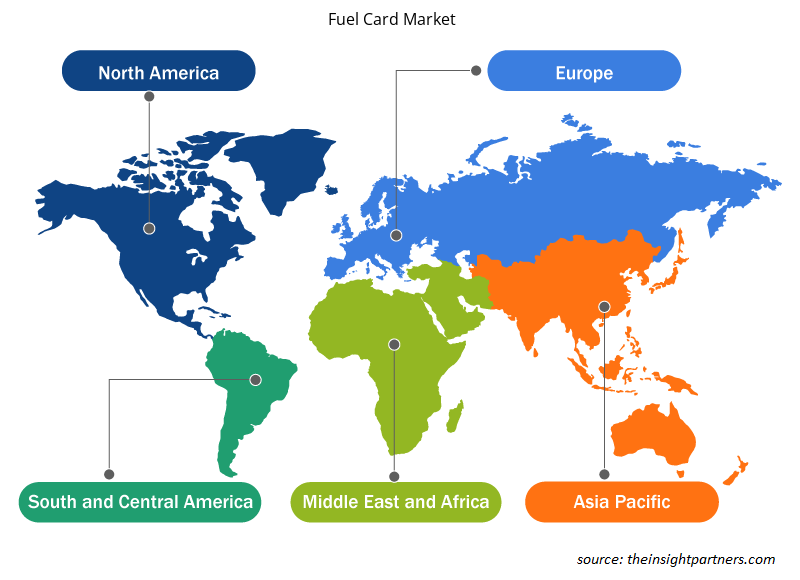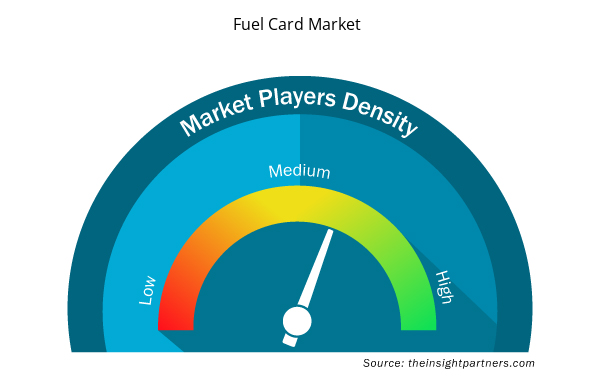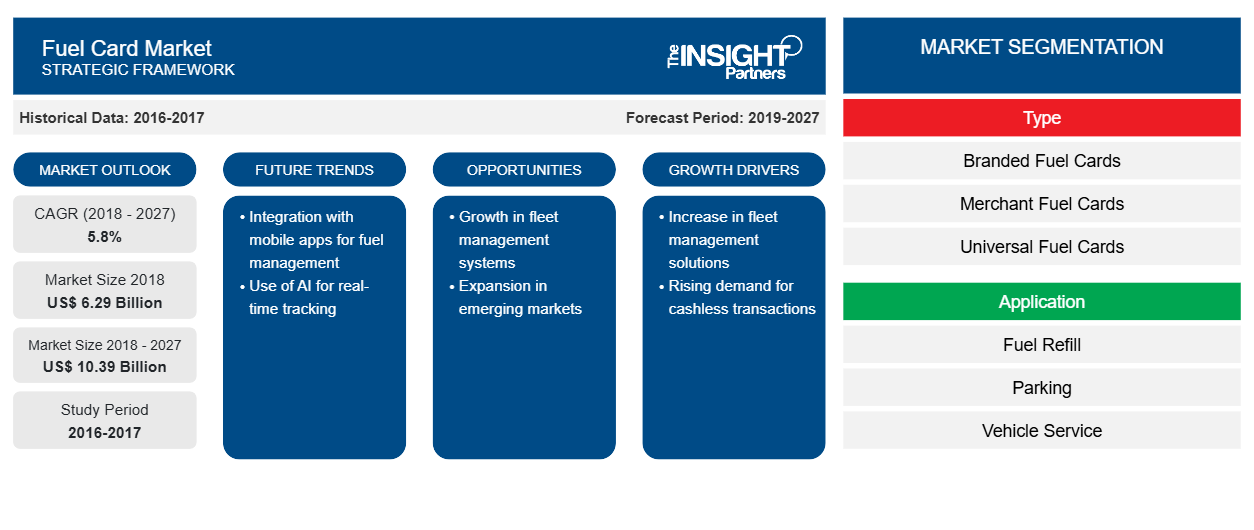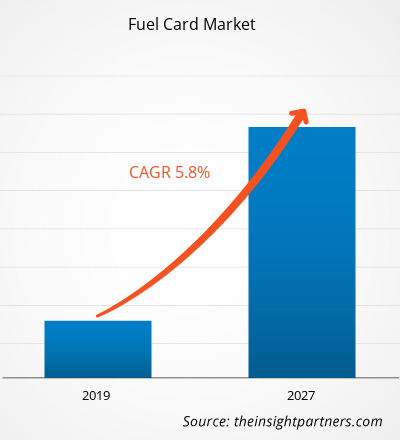[Informe de investigación] Se estima que el mercado mundial de tarjetas de combustible representará US$ 6,29 mil millones en 2018 y se espera que crezca a una CAGR del 5,8% durante el período de pronóstico 2019 - 2027, para representar US$ 10,39 mil millones para 2027.
La región de América del Norte tiene una cuota de mercado significativa en términos de ingresos generados por tarjetas de combustible y se estima que seguirá dominando la cuota de mercado durante el período de previsión. Las tarjetas universales son el tipo de tarjeta de combustible más conveniente; los proveedores de estas tarjetas suelen asociarse con varias compañías de combustible y ofrecen una gran flexibilidad. Algunas compañías de tarjetas de combustible solo operan en algunos países o regiones, mientras que otras pueden ser aceptadas solo en determinadas estaciones de servicio. Los usuarios con menos opciones en su región pueden tener que ser cautelosos a la hora de limitarlas a unas pocas estaciones de servicio.
Perspectivas del mercado de tarjetas de combustible
Administración eficiente de la flota con la ayuda de una captura de datos mejorada
Las tarjetas de combustible permiten un mejor seguimiento de los gastos y la eficiencia de la flota al rastrear el kilometraje en tiempo real y el uso de combustible de los vehículos de una flota. Los operadores de flotas utilizan tarjetas de combustible para costos como mantenimiento de camiones, reparaciones de camiones, combustible, limpieza de camiones y alquiler de vehículos de reemplazo, entre otros. Los datos capturados por una tarjeta de combustible incluyen la lectura del odómetro, los grados de combustible, el producto de combustible y la cantidad de combustible, la identificación del vehículo, la identificación del conductor e información fiscal junto con detalles de la transacción como la hora, la ubicación, el monto del gasto y la fecha, lo que respalda la renovación de soporte para los administradores de flotas. Este factor impulsaría la demanda del mercado de tarjetas de combustible en el período de pronóstico.
Personalice este informe según sus necesidades
Obtendrá personalización en cualquier informe, sin cargo, incluidas partes de este informe o análisis a nivel de país, paquete de datos de Excel, así como también grandes ofertas y descuentos para empresas emergentes y universidades.
- Obtenga las principales tendencias clave del mercado de este informe.Esta muestra GRATUITA incluirá análisis de datos, desde tendencias del mercado hasta estimaciones y pronósticos.
Menor riesgo de fraude asociado al uso de la tarjeta de combustible
El uso de tarjetas de combustible ofrece ventajas en términos de funcionalidad y seguridad en comparación con otros métodos de pago de combustible, como la caja chica. Las tarjetas pueden llevar impreso el número de matrícula del vehículo o el nombre del conductor y el nombre de la empresa, lo que proporciona una mayor protección contra el uso fraudulento de las tarjetas para repostar. La información completa sobre todas las transacciones de combustible reduce la posibilidad de que los empleados hagan un uso indebido y ofrece un mayor control sobre el uso auténtico del vehículo. Por lo tanto, se prevé que el mercado de tarjetas de combustible crezca en todo el mundo.
Información sobre segmentos de tipo
El mercado de tarjetas de combustible por componente se segmenta en tarjetas de combustible de marca, tarjetas de combustible para comerciantes y tarjetas de combustible universales. Las tarjetas de combustible suelen ser utilizadas por pymes y grandes empresas para realizar un seguimiento de su consumo de combustible y realizar pagos sin efectivo de forma cómoda. Estas tarjetas son las más comunes para las empresas u organizaciones que se dedican al transporte y la gestión de flotas. Diferentes empresas que operan en el sector ofrecen distintos tipos de tarjetas. Estas tarjetas, además de para recargar combustible, se utilizan para varios otros fines. Las tarjetas de combustible por emisor pueden ser, en líneas generales, independientes de las categorías o de marca.
Información sobre segmentos de aplicaciones
El mercado mundial de tarjetas de combustible, basado en aplicaciones, se ha segmentado en recarga de combustible, estacionamiento, servicio del vehículo, cobro de peajes y otros. Una tarjeta de combustible permite a los usuarios y propietarios de empresas gestionar y controlar los gastos de combustible y mantenimiento. Por lo general, se utilizan como tarjeta de pago para combustibles en estaciones de servicio. Además, estas tarjetas también se pueden utilizar para el pago de otros servicios del vehículo, como reparaciones, mantenimiento y asistencia en carretera. Debido a la amplia capacidad de generación de informes, varias tarjetas de combustible permiten a los usuarios obtener informes en tiempo real, lo que les ayuda a mantenerse al día de todos los gastos comerciales y a gestionar los impuestos de los vehículos.
Perspectivas regionales del mercado de tarjetas de combustible
Los analistas de Insight Partners explicaron en detalle las tendencias y los factores regionales que influyen en el mercado de tarjetas de combustible durante el período de pronóstico. Esta sección también analiza los segmentos y la geografía del mercado de tarjetas de combustible en América del Norte, Europa, Asia Pacífico, Medio Oriente y África, y América del Sur y Central.

- Obtenga los datos regionales específicos para el mercado de tarjetas de combustible
Alcance del informe sobre el mercado de tarjetas de combustible
| Atributo del informe | Detalles |
|---|---|
| Tamaño del mercado en 2018 | 6.290 millones de dólares estadounidenses |
| Tamaño del mercado en 2027 | US$ 10.39 mil millones |
| Tasa de crecimiento anual compuesta (CAGR) global (2018-2027) | 5,8% |
| Datos históricos | 2016-2017 |
| Período de pronóstico | 2019-2027 |
| Segmentos cubiertos | Por tipo
|
| Regiones y países cubiertos | América del norte
|
| Líderes del mercado y perfiles de empresas clave |
|
Densidad de actores del mercado de tarjetas de combustible: comprensión de su impacto en la dinámica empresarial
El mercado de tarjetas de combustible está creciendo rápidamente, impulsado por la creciente demanda de los usuarios finales debido a factores como la evolución de las preferencias de los consumidores, los avances tecnológicos y una mayor conciencia de los beneficios del producto. A medida que aumenta la demanda, las empresas amplían sus ofertas, innovan para satisfacer las necesidades de los consumidores y aprovechan las tendencias emergentes, lo que impulsa aún más el crecimiento del mercado.
La densidad de actores del mercado se refiere a la distribución de las empresas o firmas que operan dentro de un mercado o industria en particular. Indica cuántos competidores (actores del mercado) están presentes en un espacio de mercado determinado en relación con su tamaño o valor total de mercado.
Las principales empresas que operan en el mercado de tarjetas de combustible son:
- Sociedad Anónima de Capital Variable (BP)
- Corporación Exxon Mobil
- Tecnologías Fleetcor, Inc.
- Shell holandesa real plc
- Banco de Estados Unidos
Descargo de responsabilidad : Las empresas enumeradas anteriormente no están clasificadas en ningún orden particular.

- Obtenga una descripción general de los principales actores clave del mercado de tarjetas de combustible
Se observó que algunas de las iniciativas de mercado eran la estrategia más adoptada en el mercado mundial de tarjetas de combustible. A continuación se enumeran algunas de las iniciativas de mercado recientes:
2019: Edenred Capital Partners invierte en empresas innovadoras con un alto potencial de crecimiento en áreas relacionadas con las actividades de Edenred. El objetivo es mejorar el ecosistema del Grupo iniciando sinergias valiosas con las empresas respaldadas.
2018: Edenred, líder mundial en soluciones transaccionales para empresas, empleados y comerciantes, anunció hoy la firma de un acuerdo para adquirir el 80% del capital social del grupo The Right Fuelcard Company (TRFC), el cuarto administrador de programas de tarjetas de combustible en el Reino Unido.
SEGMENTACIÓN DEL MERCADO GLOBAL DE TARJETAS DE COMBUSTIBLE
Mercado mundial de tarjetas de combustible: por tipo
- Tarjetas de combustible de marca
- Tarjetas de combustible con marca de comerciante
- Tarjetas de combustible universales
Mercado mundial de tarjetas de combustible: por aplicación
- Recarga de combustible
- Aparcamiento
- Servicio de vehículos
- Tarifa de peaje
- Otros
Mercado mundial de tarjetas de combustible: por geografía
América del norte
- A NOSOTROS
- Canadá
- México
Europa
- Francia
- Alemania
- Italia
- Reino Unido
- España
- Resto de Europa
Asia Pacífico (APAC)
- Porcelana
- India
- Japón
- Australia
- Resto de APAC
Oriente Medio y África (MEA)
- Arabia Saudita
- Emiratos Árabes Unidos
- Sudáfrica
- Resto de Oriente Medio y África
Sudamerica
- Brasil
- Resto de Sudamérica
Mercado mundial de tarjetas de combustible: perfiles de empresas
- Sociedad Anónima de Capital Variable (BP)
- Corporación Exxon Mobil
- Tecnologías Fleetcor, Inc. Technologies, Inc.
- Shell holandesa real plcplc
- Banco de Estados Unidos Bank
- Compañía Inc.
- DKV
- Servicios de combustible mundial
- Edenerd
- Soluciones de pago Radius.
Allstar, Arco, Caltex, Chevron Texaco, Commdel, EDC, Engen Petroleum Ltd., FastFuel, Fleetcare Pty Ltd, fuelGenie y Fuelman son algunos otros actores del mercado de la cadena de valor que no están perfilados en el informe, pero que pueden incluirse según pedido.
- Análisis histórico (2 años), año base, pronóstico (7 años) con CAGR
- Análisis PEST y FODA
- Tamaño del mercado Valor/volumen: global, regional, nacional
- Industria y panorama competitivo
- Conjunto de datos de Excel


- Dropshipping Market
- Thermal Energy Storage Market
- Sleep Apnea Diagnostics Market
- Predictive Maintenance Market
- Bathroom Vanities Market
- Fixed-Base Operator Market
- Grant Management Software Market
- Transdermal Drug Delivery System Market
- Employment Screening Services Market
- Health Economics and Outcome Research (HEOR) Services Market

Report Coverage
Revenue forecast, Company Analysis, Industry landscape, Growth factors, and Trends

Segment Covered
This text is related
to segments covered.

Regional Scope
North America, Europe, Asia Pacific, Middle East & Africa, South & Central America

Country Scope
This text is related
to country scope.
Trends and growth analysis reports related to Banking, Financial Services, and Insurance : READ MORE..
The List of Companies
- BP P.L.C.
- Exxon Mobil Corporation
- Fleetcor Technologies, Inc.
- Royal Dutch Shell plc
- U.S. Bank
- Wex Inc.
- DKV
- World Fuel Services
- Edenerd
- Radius Payment Solutions
The Insight Partners performs research in 4 major stages: Data Collection & Secondary Research, Primary Research, Data Analysis and Data Triangulation & Final Review.
- Data Collection and Secondary Research:
As a market research and consulting firm operating from a decade, we have published and advised several client across the globe. First step for any study will start with an assessment of currently available data and insights from existing reports. Further, historical and current market information is collected from Investor Presentations, Annual Reports, SEC Filings, etc., and other information related to company’s performance and market positioning are gathered from Paid Databases (Factiva, Hoovers, and Reuters) and various other publications available in public domain.
Several associations trade associates, technical forums, institutes, societies and organization are accessed to gain technical as well as market related insights through their publications such as research papers, blogs and press releases related to the studies are referred to get cues about the market. Further, white papers, journals, magazines, and other news articles published in last 3 years are scrutinized and analyzed to understand the current market trends.
- Primary Research:
The primarily interview analysis comprise of data obtained from industry participants interview and answers to survey questions gathered by in-house primary team.
For primary research, interviews are conducted with industry experts/CEOs/Marketing Managers/VPs/Subject Matter Experts from both demand and supply side to get a 360-degree view of the market. The primary team conducts several interviews based on the complexity of the markets to understand the various market trends and dynamics which makes research more credible and precise.
A typical research interview fulfils the following functions:
- Provides first-hand information on the market size, market trends, growth trends, competitive landscape, and outlook
- Validates and strengthens in-house secondary research findings
- Develops the analysis team’s expertise and market understanding
Primary research involves email interactions and telephone interviews for each market, category, segment, and sub-segment across geographies. The participants who typically take part in such a process include, but are not limited to:
- Industry participants: VPs, business development managers, market intelligence managers and national sales managers
- Outside experts: Valuation experts, research analysts and key opinion leaders specializing in the electronics and semiconductor industry.
Below is the breakup of our primary respondents by company, designation, and region:

Once we receive the confirmation from primary research sources or primary respondents, we finalize the base year market estimation and forecast the data as per the macroeconomic and microeconomic factors assessed during data collection.
- Data Analysis:
Once data is validated through both secondary as well as primary respondents, we finalize the market estimations by hypothesis formulation and factor analysis at regional and country level.
- Macro-Economic Factor Analysis:
We analyse macroeconomic indicators such the gross domestic product (GDP), increase in the demand for goods and services across industries, technological advancement, regional economic growth, governmental policies, the influence of COVID-19, PEST analysis, and other aspects. This analysis aids in setting benchmarks for various nations/regions and approximating market splits. Additionally, the general trend of the aforementioned components aid in determining the market's development possibilities.
- Country Level Data:
Various factors that are especially aligned to the country are taken into account to determine the market size for a certain area and country, including the presence of vendors, such as headquarters and offices, the country's GDP, demand patterns, and industry growth. To comprehend the market dynamics for the nation, a number of growth variables, inhibitors, application areas, and current market trends are researched. The aforementioned elements aid in determining the country's overall market's growth potential.
- Company Profile:
The “Table of Contents” is formulated by listing and analyzing more than 25 - 30 companies operating in the market ecosystem across geographies. However, we profile only 10 companies as a standard practice in our syndicate reports. These 10 companies comprise leading, emerging, and regional players. Nonetheless, our analysis is not restricted to the 10 listed companies, we also analyze other companies present in the market to develop a holistic view and understand the prevailing trends. The “Company Profiles” section in the report covers key facts, business description, products & services, financial information, SWOT analysis, and key developments. The financial information presented is extracted from the annual reports and official documents of the publicly listed companies. Upon collecting the information for the sections of respective companies, we verify them via various primary sources and then compile the data in respective company profiles. The company level information helps us in deriving the base number as well as in forecasting the market size.
- Developing Base Number:
Aggregation of sales statistics (2020-2022) and macro-economic factor, and other secondary and primary research insights are utilized to arrive at base number and related market shares for 2022. The data gaps are identified in this step and relevant market data is analyzed, collected from paid primary interviews or databases. On finalizing the base year market size, forecasts are developed on the basis of macro-economic, industry and market growth factors and company level analysis.
- Data Triangulation and Final Review:
The market findings and base year market size calculations are validated from supply as well as demand side. Demand side validations are based on macro-economic factor analysis and benchmarks for respective regions and countries. In case of supply side validations, revenues of major companies are estimated (in case not available) based on industry benchmark, approximate number of employees, product portfolio, and primary interviews revenues are gathered. Further revenue from target product/service segment is assessed to avoid overshooting of market statistics. In case of heavy deviations between supply and demand side values, all thes steps are repeated to achieve synchronization.
We follow an iterative model, wherein we share our research findings with Subject Matter Experts (SME’s) and Key Opinion Leaders (KOLs) until consensus view of the market is not formulated – this model negates any drastic deviation in the opinions of experts. Only validated and universally acceptable research findings are quoted in our reports.
We have important check points that we use to validate our research findings – which we call – data triangulation, where we validate the information, we generate from secondary sources with primary interviews and then we re-validate with our internal data bases and Subject matter experts. This comprehensive model enables us to deliver high quality, reliable data in shortest possible time.


 Obtenga una muestra gratuita de este informe
Obtenga una muestra gratuita de este informe